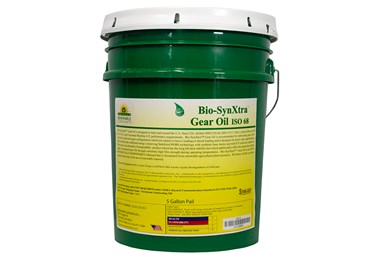Environmentally-Friendly Bio-E.P Gear Oils Perform Like Synthetics
The gear oil is said to provide longer gear life protection through extremely high film strength during elevated operating temperatures.
#metalworkingfluids
Edited by Angela Osborne
Renewable Lubricants’ biodegradable Bio-E.P. Gear Oils are well suited for lubricating spur, helical, bevel and worm gears which are subject to heavy loading or shock loading in heavy-duty applications. It is said these environmentally-friendly formulations meet or exceed the U.S. Steel 224, AGMA 9005-E02, DIN 51517 Part 3, ISO 12925-1 CKD, David Brown DB S1.53.101 and Cincinnati Machine performance requirements.
In addition to performance comparable to or exceeding synthetics, the company says these bio-based products help companies achieve their sustainability goals. Formulated from renewable agricultural bio-based resources, they are nontoxic, zinc-free formulations which contain no heavy metals. Direct replacement products are available for industrial grade, ISO grade, and AGMA products.
It is said the Bio-E.P. Gear Oils are an economical choice where leakage or contaminations are more prominent or on equipment with more frequent oil change intervals. The company says the energy-conserving stabilized BOBS technology combined with synthetic base stocks and exceptional E.P./anti-wear technology results in a super high-viscosity index (VI) product with long-life heat stability. This provides longer gear life protection through extremely high film strength during elevated operating temperatures. Rapid demulsification enables users to drain water from the system quickly to prevent corrosion, protect components and extend oil life.
Bio-E.P. Gear Oils meet the Environmental Protection Agency (EPA) 2013 Vessel General Permit (VGP) guidelines for Environmentally Acceptable Lubricants (EALs) and should be used where low toxicity, biodegradability and non-bioaccumulation properties are required. In addition to being safer for the environment, the oil is safer for employees. It also exceeds the acute toxicity (LC-50/EC-50{1000 ppm) criteria adopted by the U.S. Fish and Wildlife Service and the U.S. EPA.
RELATED CONTENT
-
Integrated Solutions for Chip Removal and Fluid Filtration
Shops can easily view chips simply as waste, hardly giving a second thought to the disposal process and the potential related savings. By keeping an eye on the waste and choosing the most efficient methods of chip disposal, a shop can easily add to the bottom line through substantial savings.
-
Oil/Coolant Mist Collector Addresses Efficiency Challenges
These oil/coolant mist collectors can contribute to employee safety and a better work environment all around.
-
Maximize Coolant Life with Efficient Tramp Oil Removal
Increased demands for high surface finish and close part tolerance create a greater need for manufacturers to purify coolants that are constantly being cycled through precision machinery.




